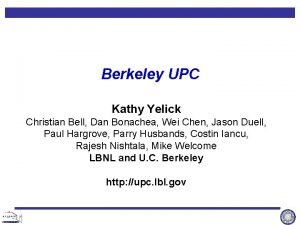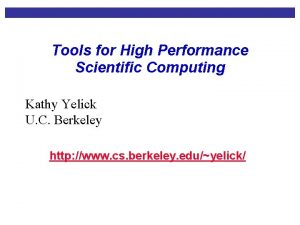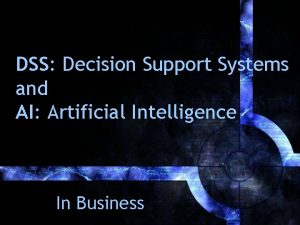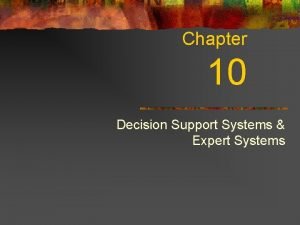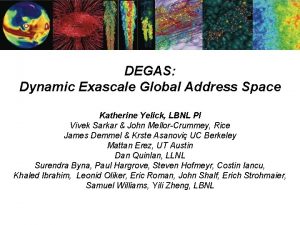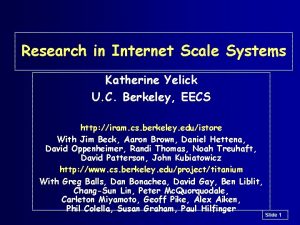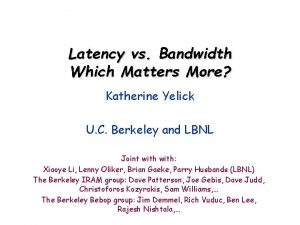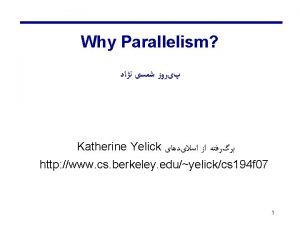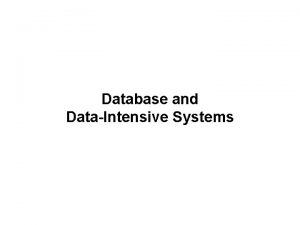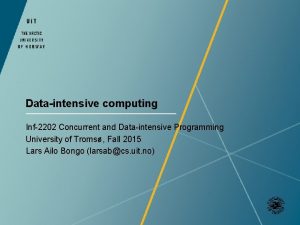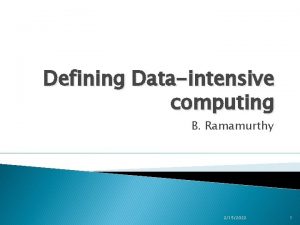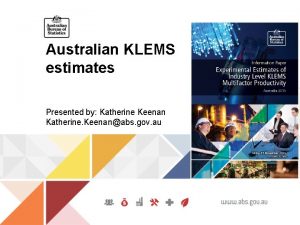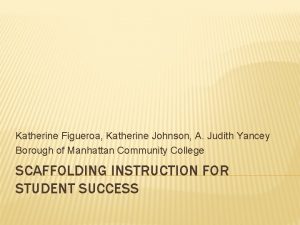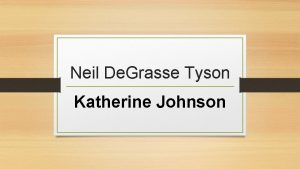System Support for DataIntensive Applications Katherine Yelick U
































































- Slides: 64

System Support for Data-Intensive Applications Katherine Yelick U. C. Berkeley, EECS Slide 1

The “Post PC” Generation Two technologies will likely dominate: 1) Mobile Consumer Electronic Devices – e. g. , PDA, Cell phone, wearable computers, with cameras, recorders, sensors – make the computing “invisible” through reliability and simple interfaces 2) Infrastructure to Support such Devices – e. g. , successor to Big Fat Web Servers, Database Servers – make these “utilities” with reliability and new economic models Slide 2

Open Research Issues • Human-computer interaction – uniformity across devices • Distributed computing – coordination across independent devices • Power – low power designs and renewable power sources • Information retrieval – finding useful information amidst a flood of data • Scalability – Scaling devices down – Scaling services up • Reliability and maintainability Slide 3

The problem space: big data • Big demand for enormous amounts of data – today: enterprise and internet applications » online applications: e-commerce, mail, web, archives » enterprise decision-support, data mining databases – future: richer data and more of it » computational & storage back-ends for mobile devices » more multimedia content » more use of historical data to provide better services • Two key application domains: – storage: public, private, and institutional data – search: building static indexes, dynamic discovery Slide 4

Reliability/Performance Trade-off • Techniques for reliability: – High level languages with strong types » avoid memory leaks, wild pointers, etc. » C vs. Java – Redundant storage, computation, etc. » adds storage and bandwidth overhead • Techniques for performance: – Optimize for a specific machine » e. g. , cache or memory hierarchy – Minimize redundancy • These two goals work against each other Slide 5

Specific Projects • ISTORE – A reliable, scalable, maintainable storage system • Data-intensive applications for “backend” servers – Modeling the real world – Storing and finding information • Titanium – A high level language (Java) with high performance – A domain-specific language and optimizing compiler • Sparsity – Optimization using partial program input Slide 6

ISTORE: Reliable Storage System • 80 -node x 86 -based cluster, 1. 4 TB storage – cluster nodes are plug-and-play, intelligent, networkattached storage “bricks” » a single field-replaceable unit to simplify maintenance – each node is a full x 86 PC w/256 MB DRAM, 18 GB disk – 2 -node system running now; full system in next quarter ISTORE Chassis 80 nodes, 8 per tray 2 levels of switches • 20 100 Mbit/s • 2 1 Gbit/s Environment Monitoring: UPS, redundant PS, fans, heat and vibration sensors. . . Intelligent Disk “Brick” Portable PC CPU: Pentium II/266 + DRAM Redundant NICs (4 100 Mb/s links) Diagnostic Processor Disk Half-height canister Slide 7

A glimpse into the future? • System-on-a-chip enables computer, memory, redundant network interfaces without significantly increasing size of disk • ISTORE HW in 5 -7 years: – building block: 2006 Micro. Drive integrated with IRAM » 9 GB disk, 50 MB/sec from disk » connected via crossbar switch – 10, 000 nodes fit into one rack! • O(10, 000) scale is our ultimate design point Slide 8

Specific Projects • ISTORE – A reliable, scalable, maintainable storage system • Data-intensive applications for “backend” servers – Modeling the real world – Storing and finding information • Titanium – A high level language (Java) with high performance – A domain-specific language and optimizing compiler • Sparsity – Optimization using partial program input Slide 9

Heart Modeling • A computer simulation of a human heart – Used to design artificial heart valves – Simulations run for days on a C 90 supercomputer – Done by Peskin and Mac. Queen at NYU • Modern machines are faster but harder to use – working with NYU – using Titanium • Shown here: close-up of aortic valve during ejection • Images from the Pittsburgh Supercomputer Center Slide 10

Simulation of a Beating Heart • Shown here: – Aortic valve (yellow); Mitral valve (purple) – Mitral valves closes when left ventrical pumps • Future: virtual surgery? Slide 11

Earthquake Simulation • Earthquake modeling – Used for retrofitting buildings, emergency preparedness, construction policies – Done by Beilak (CMU); also by Fenves (Berkeley) – Problems: grid (graph) generation; using images Slide 12

Earthquake Simuation • Movie shows a simulated aftershock following the 1994 Northridge earthquake in California • Future: sensors everywhere; tied to central system Slide 13

Pollution Standards • Simulation of ozone layer – Done by Russell (CMU) and Mc. Rae (MIT) – Used to influence automobile emissions policy Los Angeles Basin shown at 8 am (left) and 2 pm (right) The “cloud” shows areas where ozone levels are above federal ambient air quality standards (0. 12 parts per million) Slide 14

Information Retrieval • Finding useful information amidst huge data sets – I/O intensive application • Today’s example: web search engines – 10 Million documents in typical matrix. – Web storage increasing 2 x every 5 months – One class of techniques based on sparse matrices # documents ~= 10 M # keywords ~100 K x • Matrix is compressed • “Random” memory access • Cache miss per 2 Flops • Run at 1 -5% of machine peak • Problem: Can you make this run faster, without writing hand-optimized, non-portable code? Slide 15

Image-Based Retrieval • Digital library problem: – retrieval on images – content-based • Computer vision problem – uses sparse matrix • Future: search in medical image databases; diagnosis; epidemiological studies Slide 16

Object Based Image Description Slide 17

Specific Projects • ISTORE – A reliable, scalable, maintainable storage system • Data-intensive applications for “backend” servers – Modeling the real world – Storing and finding information • Titanium – A high level language (Java) with high performance – A domain-specific language and optimizing compiler • Sparsity – Optimization using partial program input Slide 18

Titanium Goals • Help programmers write reliable software – Retain safety properties of Java – Extend to parallel programming constructs • Performance – Sequential code comparable to C/C++/Fortran – Parallel performance comparable to MPI • Portability • How? – Domain-specific language and compiler – No JVM – Optimizing compiler – Explicit parallelism and other language constructs for high performance Slide 19

Titanium Overview: Sequential Object-oriented language based on Java with: • Immutable classes – user-definable non-reference types for performance • Unordered loops – compiler is free to run iteration in any order – useful for cache optimizations and others • Operator overloading – by demand from our user community • Multidimensional arrays – points and index sets as first-class values – specific to an application domain: scientific computing with block-structured grids Slide 20

Titanium Overview: Parallel Extensions of Java for scalable parallelism: • Scalable parallelism – SPMD model with global address space • Global communication library – E. g. , broadcast, exchange (all-to-all) – Used to build data structures in the global address space • Parallel Optimizations – Pointer operations – Communication (underway) • Bulk asynchronous I/O – speed with safety Slide 21

Implementation • Strategy – Compile Titanium into C – Communicate through shared memory on SMPs – Lightweight communication for distributed memory • Titanium currently runs on: – Uniprocessors – SMPs with Posix or Solaris threads – Berkeley NOW, SP 2 (distributed memory) – Tera MTA (multithreaded, hierarchical) – Cray T 3 E (global address space) – SP 3 (cluster of SMPs, e. g. , Blue Horizon at SDSC) Slide 22

Sequential Performance Java Ultrasparc: C/C++/ FORTRAN Arrays DAXPY 3 D multigrid 2 D multigrid EM 3 D 1. 4 s 12 s 5. 4 s 0. 7 s 6. 8 s 1. 8 s Java Pentium II: C/C++/ FORTRAN Arrays DAXPY 3 D multigrid 2 D multigrid EM 3 D 1. 8 s 23. 0 s 7. 3 s 1. 0 s Titanium Arrays 1. 5 s 22 s 6. 2 s 1. 0 s Titanium Arrays 2. 3 s 20. 0 s 5. 5 s 1. 6 s Overhead 7% 83% 15% 42% Overhead 27% -13% -25% 60% Performance results from 98; new IR and optimization framework almost complete. Slide 23

SPMD Execution Model • Java programs can be run as Titanium, but the result will be that all processors do all the work • E. g. , parallel hello world class Hello. World { public static void main (String [] argv) { System. out. println(‘’Hello from proc ‘’ + Ti. this. Proc()); } } • Any non-trivial program will have communication and synchronization Slide 24

SPMD Execution Model • A common style is compute/communicate • E. g. , in each timestep within particle simulation with gravitation attraction read all particles and compute forces on mine Ti. barrier(); write to my particles using new forces Ti. barrier(); • This basic model is used on the large-scale parallel simulations described earlier Slide 25

SPMD Model • All processor start together and execute same code, but not in lock-step • Basic control done using – Ti. num. Procs() total number of processors – Ti. this. Proc() number of executing processor • Sometimes they do something independent if (Ti. this. Proc() == 0) { …. . do setup. . … } System. out. println(‘’Hello from ‘’ + Ti. this. Proc()); double [1 d] a = new double [Ti. num. Procs()]; Slide 26

Barriers and Single • Common source of bugs is barriers or other global operations inside branches or loops barrier, broadcast, reduction, exchange • A “single” method is one called by all procs public single static void all. Step(. . . ) • A “single” variable has same value on all procs int single timestep = 0; • The compiler uses “single” type annotations to ensure there are no synchronization bugs with barriers Slide 27

Explicit Communication: Exchange • To create shared data structures – each processor builds its own piece – pieces are exchanged (for object, just exchange pointers) • Exchange primitive in Titanium int [1 d] single all. Data; all. Data = new int [0: Ti. num. Procs()-1]; all. Data. exchange(Ti. this. Proc()*2); • E. g. , on 4 procs, each will have copy of all. Data: 0 2 4 6 Slide 28

Exchange on Objects • More interesting example: class Boxed { public Boxed (int j) { val = j; } public in val; } Object [1 d] single all. Data; all. Data = new Object [0: Ti. num. Procs()-1]; all. Data. exchange(new Boxed(Ti. this. Proc()); Slide 29

Use of Global / Local • As seen, references (pointers) may be remote – easy to port shared-memory programs • Global pointers are more expensive than local – True even when data is on the same processor – Use local declarations in critical sections • Costs of global: – space (processor number + memory address) – dereference time (check to see if local) • May declare references as local Slide 30

Global Address Space • Processes allocate locally • References can be passed to other processes Class C { int val; …. . } C gv; // global pointer C local lv; // local pointer Process 0 Other processes lv lv gv gv if (this. Proc() == 0) { lv = new C(); } gv = broadcast lv from 0; gv. val = …. . ; …. . = gv. val; Slide 31

Local Pointer Analysis • Compiler can infer many uses of local – “Local Qualification Inference” (Liblit’s work) • Data structures must be well partitioned Slide 32

Bulk Asynchronous I/O Performance External sort benchmark on NOW • raf: random access file (Java) • ds: unbuffered stream (Java) • dsb: buffered stream (Java) • bulkraf: bulk random access (Titanium) • bulkds: bulk sequential (Titanium) • async: asynchronous (Titanium) Slide 33

Performance Heterogeneity • System performance limited by the weakest link • Performance heterogeneity is the norm – disks: inner vs. outer track (50%), fragmentation – processors: load (1. 5 -5 x) • Virtual Streams: dynamically off-load I/O work from slower disks to faster ones Slide 34

Parallel performance on an SMP • Speedup on Ultrasparc SMP (shared memory multiprocessor) • EM 3 D performance linear – simple kernel • AMR largely limited by – problem size – 2 levels, with top one serial Slide 35

Parallel Performance on a NOW • MLC for Finite-Differences by Balls and Colella • Poisson equation with infinite boundaries – arise in astrophysics, some biological systems, etc. • Method is scalable – Low communication • Performance on – SP 2 (shown) and t 3 e – scaled speedups – nearly ideal (flat) • Currently 2 D and non-adaptive Slide 36

Performance on CLUMPs • Clusters of SMPs (CLUMPs) have two-levels of communication – BH at SDSC has 144 nodes, each with 8 nodes – 8 th processor cannot be used effectively Slide 37

Cluster of SMPs • Communication within a node is shared-memory • Communication between nodes uses LAPI – for large messages, a separate thread is created by LAPI – interferes with computation performance Slide 38

Optimizing Parallel Programs • Would like compiler to introduce asynchronous communication, which is a form of possible reordering • Hardware also reorders – out-of-order execution – write buffered with read by-pass – non-FIFO write buffers • Software already reorders too – register allocation – any code motion • System provides enforcement primitives – volatile: at the language level not well-defined – tend to be heavy weight, unpredictable • Can the compiler hide all this? Slide 39

Semantics: Sequential Consistency • When compiling sequential programs: x = expr 1; y = expr 2; x = expr 1; Valid if y not in expr 1 and x not in expr 2 (roughly) • When compiling parallel code, not sufficient test. Initially flag = data = 0 Proc A Proc B data = 1; while (flag==1); flag = 1; . . . =. . . data. . . ; Slide 40

Cycle Detection: Dependence Analog • Processors define a “program order” on accesses from the same thread P is the union of these total orders • Memory system define an “access order” on accesses to the same variable A is access order (read/write & write/write pairs) write data read flag write flag read data • A violation of sequential consistency is cycle in P U A. • Intuition: time cannot flow backwards. Slide 41

Cycle Detection • Generalizes to arbitrary numbers of variables and processors write x read y write y read y write x • Cycles may be arbitrarily long, but it is sufficient to consider only cycles with 1 or 2 consecutive stops per processor [Sasha & Snir] Slide 42

Static Analysis for Cycle Detection • Approximate P by the control flow graph • Approximate A by undirected “dependence” edges • Let the “delay set” D be all edges from P that are part of a minimal cycle write z read x write y read x write z • The execution order of D edge must be preserved; other P edges may be reordered (modulo usual rules about serial code) • Synchronization analsysis also critical [Krishnamurthy] Slide 43

Automatic Communication Optimization Time (normalized) • Implemented in subset of C with limited pointers • Experiments on the NOW; 3 synchronization styles • Future: pointer analysis and optimizations Slide 44

Specific Projects • ISTORE – A reliable, scalable, maintainable storage system • Data-intensive applications for “backend” servers – Modeling the real world – Storing and finding information • Titanium – A high level language (Java) with high performance – A domain-specific language and optimizing compiler • Sparsity – Optimization using partial program input Slide 45

Sparsity: Sparse Matrix Optimizer • Several data mining or web search algorithms use sparse matrix-vector multiplication – use for documents, images, video, etc. – irregular, indirect memory patterns perform poorly on memory hierarchies • Performance improvements possible, but depend on: – sparsity structure, e. g. , keywords within documents – machine parameters without analytical models • Good news: – operation repeated many times on similar matrix – Sparsity: automatic code generator based on matrix structure and machine Slide 46

Sparsity: Sparse Matrix Optimizer Slide 47

Summary • Future – small devices + larger servers – reliability increasingly important • Reliability techniques include – hardware: redundancy, monitoring – software: better languages, many others • Performance trades off against safety in languages – use of domain-specific features (e. g. , Titanium) Slide 48

Backup Slides Slide 49

The Big Motivators for Programming Systems Research • Ease of Programming – Hardware costs -> 0 – Software costs -> infinity • Correctness – Increasing reliance on software increases cost of software errors (medical, financial, etc. ) • Performance – Increasing machine complexity – New languages and applications » Enabling Java; network packet filters Slide 50

The Real Scalability Problems: AME • Availability – systems should continue to meet quality of service goals despite hardware and software failures and extreme load • Maintainability – systems should require only minimal ongoing human administration, regardless of scale or complexity • Evolutionary Growth – systems should evolve gracefully in terms of performance, maintainability, and availability as they are grown/upgraded/expanded • These are problems at today’s scales, and will only get worse as systems grow Slide 51

Research Principles • Redundancy everywhere, no single point of failure • Performance secondary to AME – Performance robustness over peak performance – Dedicate resources to AME » biological systems use > 50% of resources on maintenance – Optimizations viewed as AME-enablers » e. g. , use of (slower) safe languages like Java with static and dynamic optimizations • Introspection – reactive techniques to detect and adapt to failures, workload variations, and system evolution – proactive techniques to anticipate and avert problems before they happen Slide 52

Outline • Motivation • Hardware Techniques – general techniques – ISTORE projects • Software Techniques • Availability Benchmarks • Conclusions Slide 53

Hardware techniques • Fully shared-nothing cluster organization – truly scalable architecture, automatic redundancy – tolerates partial hardware failure • No Central Processor Unit: distribute processing with storage – Most storage servers limited by speed of CPUs; why does this make sense? – Amortize sheet metal, power, cooling infrastructure for disk to add processor, memory, and network • On-demand network partitioning/isolation – Applications must tolerate these anyway – Allows testing, repair of online system Slide 54

Hardware techniques • Heavily instrumented hardware – sensors for temp, vibration, humidity, power • Independent diagnostic processor on each node – remote control of power, console, boot code – collects, stores, processes environmental data – connected via independent network • Built-in fault injection capabilities – Used for proactive hardware introspection » automated detection of flaky components » controlled testing of error-recovery mechanisms – Important for AME benchmarking Slide 55

ISTORE-2 Hardware Proposal • Smaller disks – replace 3. 5” disks with 2. 5” or 1” drives » 340 MB available now in 1”, 1 GB next year (? ) • Smaller, more highly integrated processors – E. g. , Transmeta Crusoe includes processor and Northbridge (interface) functionality in 1 Watt – Xilinx FPGA for Southbridge, diagnostic proc, etc. • Larger scale – Roughly 1000 nodes, depending on support » ISTORE-1 built with donated disks, memory, processors » Paid for network, board design, enclosures (discounted) Slide 56

Outline • Motivation • Hardware Techniques • Software Techniques – general techniques – Titanium: a high performance Java dialect – Sparsity: using dynamic information – Virtual streams: performance robustness • Availability Benchmarks • Conclusions Slide 57

Software techniques • Fault tolerant data structures – Application controls replication, checkpointing, and consistency policy – Self-scrubbing used to identify software errors that have corrupted application state • Encourage use of safe languages – Type safety and automatic memory management avoid a host of application errors – Use of static and dynamic information to meet performance needs • Runtime adaptation to performance heterogeneity – e. g. , outer vs. inner track (1. 5 X), fragmentation – Evolution of systems adds to this problem Slide 58

Software Techniques • Reactive introspection – Use statistical techniques to identify normal behavior and detect deviations from it » e. g. , network activity, response time, program counter (? ) – Semi-automatic response to abnormal behavior » initially, rely on human administrator » eventually, system learns to set response parameters • Proactive introspection – Continuous online self-testing » in deployed systems! » goal is to shake out bugs in failure response code on isolated subset » use of fault-injection and stress testing Slide 59

Techniques for Safe Languages Titanium: A high performance dialect of Java • Scalable parallelism – A global address space, but not shared memory – For tightly-coupled applications, e. g. , mining – Safe, region-based memory management • Scalar performance enhancements, some specific to application domain – immutable classes (avoids indirection) – multidimensional arrays with subarrays • Application domains – scientific computing on grids » typically +/-20% of C++/F in this domain – data mining in progress Slide 60

Use of Static Information • Titanium compiler performs parallel optimizations – communication overlap (40%) and aggregation • Uses two new analyses – synchronization analysis: the parallel analog to control flow analysis » identifies code segments that may execute in parallel – shared variable analysis: the parallel analog to dependence analysis » recognize when reordering can be observed by another processor » necessary for any code motion or use of relaxed memory models in hardware => missed or illegal optimizations Slide 61

Conclusions • Two key applications domains – Storage: loosely coupled – Search: tightly coupled, computation important • Key challenges to future servers are: – Availability, Maintainability, and Evolutionary growth • Use of self-monitoring to satisfy AME goals – Proactive and reactive techniques • Use of static techniques for high performance and reliable software – Titanium extension of Java • Use of dynamic information for performance robustness – Sparsity and Virtual Streams • Availability benchmarks a powerful tool? Slide 62

Projects and Participants ISTORE: iram. cs. berkeley. edu/istore With James Beck, Aaron Brown, Daniel Hettena, David Oppenheimer, Randi Thomas, Noah Treuhaft, David Patterson, John Kubiatowicz Titanium: www. cs. berkeley. edu/projects/titanium With Greg Balls, Dan Bonachea, David Gay, Ben Liblit, Chang-Sun Lin, Peter Mc. Quorquodale, Carleton Miyamoto, Geoff Pike, Alex Aiken, Phil Colella, Susan Graham, Paul Hilfinger Sparsity: www. cs. berkeley. edu/~ejim/sparsity With Eun-Jin Im Slide 63

History of Programming Language Research General Purpose Language Design Parsing Theory Domain-Specific Language Design Type Systems Theory Flop optimization Memory Optimizations Data and Control Analysis Program Verification 70 s Garbage Collection Type-Based Analysis Threads Program Checking Tools 80 s 90 s 2 K Slide 64
 Christian yellick
Christian yellick Christian yelick
Christian yelick Kathy yelick
Kathy yelick Shmemga
Shmemga Example of major point
Example of major point Expert system vs decision support system
Expert system vs decision support system Expert system and decision support system
Expert system and decision support system Expert system and decision support system
Expert system and decision support system Kontinuitetshantering i praktiken
Kontinuitetshantering i praktiken Novell typiska drag
Novell typiska drag Tack för att ni lyssnade bild
Tack för att ni lyssnade bild Returpilarna
Returpilarna Varför kallas perioden 1918-1939 för mellankrigstiden?
Varför kallas perioden 1918-1939 för mellankrigstiden? En lathund för arbete med kontinuitetshantering
En lathund för arbete med kontinuitetshantering Adressändring ideell förening
Adressändring ideell förening Personlig tidbok
Personlig tidbok Sura för anatom
Sura för anatom Densitet vatten
Densitet vatten Datorkunskap för nybörjare
Datorkunskap för nybörjare Boverket ka
Boverket ka Hur skriver man en tes
Hur skriver man en tes För och nackdelar med firo
För och nackdelar med firo Nyckelkompetenser för livslångt lärande
Nyckelkompetenser för livslångt lärande Påbyggnader för flakfordon
Påbyggnader för flakfordon Lufttryck formel
Lufttryck formel Svenskt ramverk för digital samverkan
Svenskt ramverk för digital samverkan Jag har gått inunder stjärnor text
Jag har gått inunder stjärnor text Presentera för publik crossboss
Presentera för publik crossboss Argument för teckenspråk som minoritetsspråk
Argument för teckenspråk som minoritetsspråk Plats för toran ark
Plats för toran ark Klassificeringsstruktur för kommunala verksamheter
Klassificeringsstruktur för kommunala verksamheter Luftstrupen för medicinare
Luftstrupen för medicinare Bästa kameran för astrofoto
Bästa kameran för astrofoto Cks
Cks Verifikationsplan
Verifikationsplan Mat för unga idrottare
Mat för unga idrottare Verktyg för automatisering av utbetalningar
Verktyg för automatisering av utbetalningar Rutin för avvikelsehantering
Rutin för avvikelsehantering Smärtskolan kunskap för livet
Smärtskolan kunskap för livet Ministerstyre för och nackdelar
Ministerstyre för och nackdelar Tack för att ni har lyssnat
Tack för att ni har lyssnat Hur ser ett referat ut
Hur ser ett referat ut Redogör för vad psykologi är
Redogör för vad psykologi är Stål för stötfångarsystem
Stål för stötfångarsystem Tack för att ni har lyssnat
Tack för att ni har lyssnat Borra hål för knoppar
Borra hål för knoppar Vilken grundregel finns det för tronföljden i sverige?
Vilken grundregel finns det för tronföljden i sverige? Standardavvikelse formel
Standardavvikelse formel Tack för att ni har lyssnat
Tack för att ni har lyssnat Rita perspektiv
Rita perspektiv Ledningssystem för verksamhetsinformation
Ledningssystem för verksamhetsinformation Tobinskatten för och nackdelar
Tobinskatten för och nackdelar Blomman för dagen drog
Blomman för dagen drog Modell för handledningsprocess
Modell för handledningsprocess Egg för emanuel
Egg för emanuel Elektronik för barn
Elektronik för barn Mantel som bars av kvinnor i antikens rom
Mantel som bars av kvinnor i antikens rom Strategi för svensk viltförvaltning
Strategi för svensk viltförvaltning Var 1721 för stormaktssverige
Var 1721 för stormaktssverige Humanitr
Humanitr Romarriket tidslinje
Romarriket tidslinje Tack för att ni lyssnade
Tack för att ni lyssnade Större och mindre tecken
Större och mindre tecken Skriven med rytm och rim
Skriven med rytm och rim Inköpsprocessen steg för steg
Inköpsprocessen steg för steg
